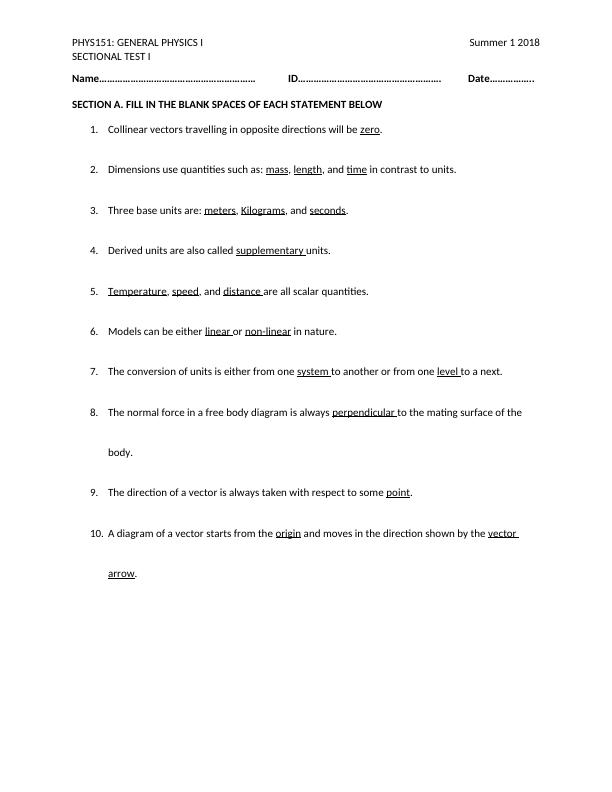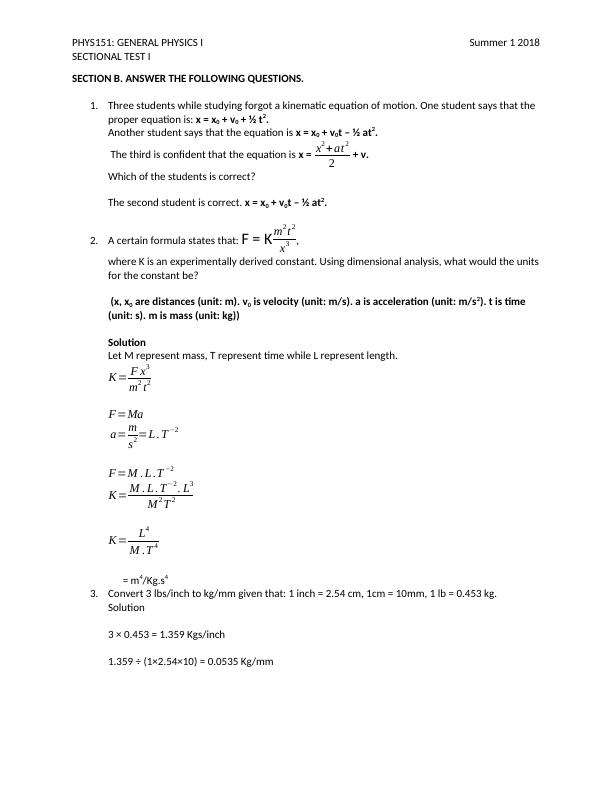PHYS151: General Physics I Sectional Test I
Added on 2023-06-03
5 Pages804 Words249 Views
PHYS151: GENERAL PHYSICS I Summer 1 2018
SECTIONAL TEST I
Name............................................................ ID....................................................... Date.................
SECTION A. FILL IN THE BLANK SPACES OF EACH STATEMENT BELOW
1. Collinear vectors travelling in opposite directions will be zero.
2. Dimensions use quantities such as: mass, length, and time in contrast to units.
3. Three base units are: meters, Kilograms, and seconds.
4. Derived units are also called supplementary units.
5. Temperature, speed, and distance are all scalar quantities.
6. Models can be either linear or non-linear in nature.
7. The conversion of units is either from one system to another or from one level to a next.
8. The normal force in a free body diagram is always perpendicular to the mating surface of the
body.
9. The direction of a vector is always taken with respect to some point.
10. A diagram of a vector starts from the origin and moves in the direction shown by the vector
arrow.
SECTIONAL TEST I
Name............................................................ ID....................................................... Date.................
SECTION A. FILL IN THE BLANK SPACES OF EACH STATEMENT BELOW
1. Collinear vectors travelling in opposite directions will be zero.
2. Dimensions use quantities such as: mass, length, and time in contrast to units.
3. Three base units are: meters, Kilograms, and seconds.
4. Derived units are also called supplementary units.
5. Temperature, speed, and distance are all scalar quantities.
6. Models can be either linear or non-linear in nature.
7. The conversion of units is either from one system to another or from one level to a next.
8. The normal force in a free body diagram is always perpendicular to the mating surface of the
body.
9. The direction of a vector is always taken with respect to some point.
10. A diagram of a vector starts from the origin and moves in the direction shown by the vector
arrow.

PHYS151: GENERAL PHYSICS I Summer 1 2018
SECTIONAL TEST I
SECTION B. ANSWER THE FOLLOWING QUESTIONS.
1. Three students while studying forgot a kinematic equation of motion. One student says that the
proper equation is: x = x0 + v0 + ½ t2.
Another student says that the equation is x = x0 + v0t – ½ at2.
The third is confident that the equation is x = x2 + at2
2 + v.
Which of the students is correct?
The second student is correct. x = x0 + v0t – ½ at2.
2. A certain formula states that: F = K m2 t2
x3 ,
where K is an experimentally derived constant. Using dimensional analysis, what would the units
for the constant be?
(x, x0 are distances (unit: m). v0 is velocity (unit: m/s). a is acceleration (unit: m/s2). t is time
(unit: s). m is mass (unit: kg))
Solution
Let M represent mass, T represent time while L represent length.
K= F x3
m2 t2
F=Ma
a= m
s2 =L . T−2
F=M . L .T −2
K= M . L . T−2 . L3
M 2 T 2
K= L4
M .T 4
= m4/Kg.s4
3. Convert 3 lbs/inch to kg/mm given that: 1 inch = 2.54 cm, 1cm = 10mm, 1 lb = 0.453 kg.
Solution
3 × 0.453 = 1.359 Kgs/inch
1.359 ÷ (1×2.54×10) = 0.0535 Kg/mm
SECTIONAL TEST I
SECTION B. ANSWER THE FOLLOWING QUESTIONS.
1. Three students while studying forgot a kinematic equation of motion. One student says that the
proper equation is: x = x0 + v0 + ½ t2.
Another student says that the equation is x = x0 + v0t – ½ at2.
The third is confident that the equation is x = x2 + at2
2 + v.
Which of the students is correct?
The second student is correct. x = x0 + v0t – ½ at2.
2. A certain formula states that: F = K m2 t2
x3 ,
where K is an experimentally derived constant. Using dimensional analysis, what would the units
for the constant be?
(x, x0 are distances (unit: m). v0 is velocity (unit: m/s). a is acceleration (unit: m/s2). t is time
(unit: s). m is mass (unit: kg))
Solution
Let M represent mass, T represent time while L represent length.
K= F x3
m2 t2
F=Ma
a= m
s2 =L . T−2
F=M . L .T −2
K= M . L . T−2 . L3
M 2 T 2
K= L4
M .T 4
= m4/Kg.s4
3. Convert 3 lbs/inch to kg/mm given that: 1 inch = 2.54 cm, 1cm = 10mm, 1 lb = 0.453 kg.
Solution
3 × 0.453 = 1.359 Kgs/inch
1.359 ÷ (1×2.54×10) = 0.0535 Kg/mm

End of preview
Want to access all the pages? Upload your documents or become a member.
Related Documents
Mathematical Methods of Conceptual Engineering Exampleslg...
|9
|1457
|383
Mechanical engineering assignmentlg...
|16
|594
|102
